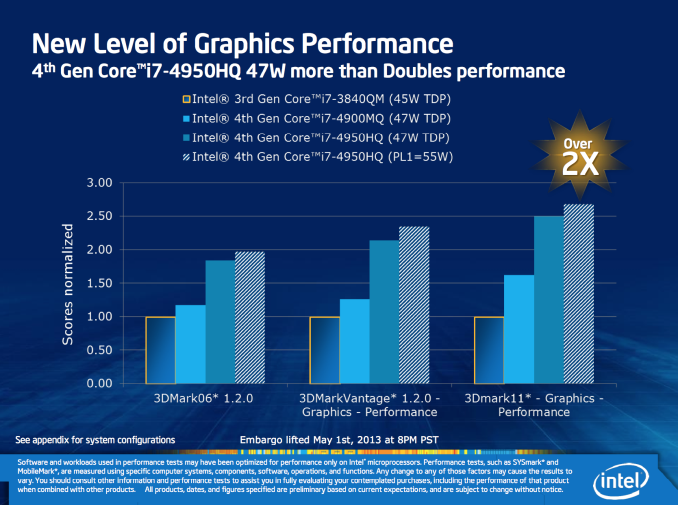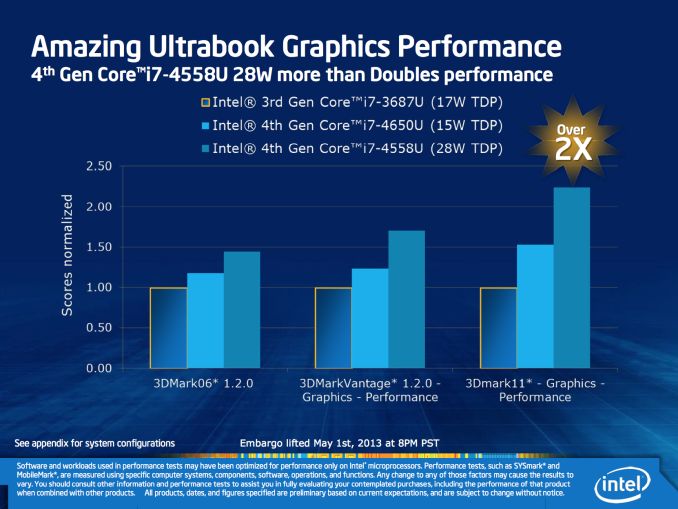Some Haswell TDPs Revealed: 15W & 28W Ultrabooks
by Anand Lal Shimpi on May 2, 2013 2:08 AM EST
Tonight Intel gave its (high-end) processor graphics a new name: Iris. Along with the new brand disclosure, Intel did let a few details slip about Haswell TDPs.
High-end desktop parts creep up to 84W (Core i7-4770K). All socketed desktop Haswell CPUs will either use Intel HD Graphics (GT1) or Intel HD Graphics 4xxxx (GT2). There's a new category of BGA-only (non-socketed) desktop CPU with an R-suffix that will ship with Intel Iris Pro graphics 5200 (GT3e). These R-series SKUs will top out at 65W, implying lower max CPU frequencies than the K-series SKUs but obviously delivering better graphics performance.
Quad-core notebook parts climb up from 45W to 47W, and these are the only parts that have the chance of getting Iris Pro graphics. Based on what we know thus far, an H-suffix seems to imply Iris Pro (Core i7-4950HQ) while an M-suffix is plain old Iris (Core i7-4900MQ). With an increase in TDP, it's entirely possible that we won't see any battery life improvement from quad-core mobile Ivy Bridge to Haswell unless you start including power savings from potentially getting rid of a discrete GPU.
Finally, the more interesting TDPs we have are down in Ultrabooks - these are parts that we've been calling Haswell ULT. Currently, Ultrabooks use 17W Ivy Bridge parts but those TDPs drop slightly with Haswell ULT down to 15W. There's no room for Iris down in the 15W range (power constraints, Intel doesn't want to regress on CPU performance), however Intel will be introducing 28W Haswell ULT parts to enable 14/15" and larger Ultrabooks with Iris graphics. The inclusion of a 28W Ultrabook part is very interesting as it clearly goes after notebooks like the ASUS UX32VD that attempted to pair a low end discrete GPU with low-power Intel silicon. Intel definitely has its eyes set on eating more of the BoM in the PC market, at the expense of the discrete GPU vendors of course. It will be very interesting to see how things play out over this next generation with low-end to mid-range discrete GPU attach rates.












30 Comments
View All Comments
Zandros - Thursday, May 2, 2013 - link
A few have GT3 graphics (HD5000), most have HD4600 IIRC. As we saw in the previous article, only HD5100 and up get Iris branding.yhselp - Thursday, May 2, 2013 - link
For years we've been reading how Intel's Haswell architecture would finally bring mobile TDPs down to the 10-20W range. Now it all seems like a bunch of marketing talk - what we actually get is +2W on standard voltage parts and -2W on ultra-low voltage parts. Would Intel even include a 10W one-chip ULV part as reported recently?What could have Intel possibly meant by putting Haswell and 10-20W in the same sentence in the past, that Haswell is the first step towards such TDPs? If so it doesn't seem likely we'd see such thermals across the board until a mature 10nm process, which pretty much means 2017.
kirilmatt - Saturday, May 4, 2013 - link
This is why we need AMD. Intel no longer has reason to deliver anymore with no competition. I hope Kaveri, Kabini and Temash make Intel actually innovate for once. I personally am waiting for KaveriLonyo - Thursday, May 2, 2013 - link
TDP is just a design power.If I have a 17w or 15w TDP, I can make it limit itself to 10w by reducing clockspeed.
The more important thing is the lower power states, since that's where a CPU will be most of the time in tablet type workloads.
How often are you going to max your tablet CPU?
Sure, it might be a little disappointing that TDPs of what's been shown so far aren't that far down, but that doesn't mean battery life won't be potentially significantly improved.
rootheday - Thursday, May 2, 2013 - link
Don't forget that the ultrabook parts at 15w also include the PCH and the integrated voltage regulator - components that are not included in the 17w on previous generation. Factoring those extra ingredients in means that the CPU/gpu/cache/memory controller/display power is more like 11w budget for apples-to-apples vs IvyBridge.The 15w Haswells have U sku names; There may also be Y skus that hit lower power envelopes.
yhselp - Thursday, May 2, 2013 - link
I'm well aware of this, as mentioned in the original post, however, Intel led the public to believe (or is that just me?) Haswell's ULV parts would be 10W in a recent presentation; they even went as far as to demo a 7W part (Y). And while it's undeniable we're getting faster, more efficient hardware, it's all going a bit slower than expected, at least for me.Amagus - Thursday, May 2, 2013 - link
10W and sub-10W parts are coming later in the year. They won't be part of the initial launch.RU482 - Thursday, May 2, 2013 - link
yes - those are the Y-SKU. the were originally slated to be 7.5W "SDP", but that has recently been reduced to 6W!kirilmatt - Saturday, May 4, 2013 - link
SDP is really a scam, they should measure everything on the same scale, "Y" series chips are just marketingConficio - Thursday, May 2, 2013 - link
Any word on what resolutions these comparisons are made on?I'm hoping for next gen notebooks to be at minimum 1920x1080 or better (although I don't hold my breath) 1920x1200. Not to speak of retina displays.
And I don't care about gaming, OS UI, video, web rendering is just fine for me.